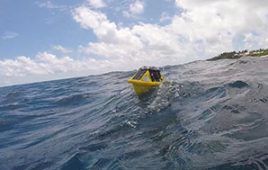Five must-read stories from the past week include exploring the limits of life in the Universe; the fastest moving glacier in the world shedding a significant iceberg; Stephen Hawking’s new solution to the black hole mystery; one of the great disputes of 20th-century physics: the story of Philipp Lenard and Albert Einstein; and solving the ancient lunar fire fountain mystery.
 Solving the Ancient Lunar Fire Fountain Mystery
Solving the Ancient Lunar Fire Fountain Mystery
Tiny beads of volcanic glass found on the lunar surface during the Apollo missions are a sign that fire fountain eruptions took place on the Moon’s surface. Now, scientists have identified the volatile gas that drove those eruptions. Fire fountains, a type of eruption that occurs frequently in Hawaii, require the presence of volatiles mixed in with the erupting lava.
 When Science gets Ugly: The story of Philipp Lenard and Albert Einstein
When Science gets Ugly: The story of Philipp Lenard and Albert Einstein
Scientists are not always as scientific as many suppose. Recent well-publicized cases of scientific fraud prove that scientists can be as susceptible to the allures of wealth, power and fame as politicians, the group that enjoys the lowest public trust. Glaring recent cases have included falsified results in the development of an HIV vaccine and new techniques for producing stem cells.
 Hawking Offers New Solution to Black Hole Mystery: Black Holes Store, and Garble, Information
Hawking Offers New Solution to Black Hole Mystery: Black Holes Store, and Garble, Information
Black holes don’t actually swallow and destroy physical information, according to an idea proposed by Stephen Hawking at the Hawking Radiation conference being held at KTH Royal Institute of Technology. Instead, they store it in a two-dimensional hologram. One of the most baffling questions facing a generation of physicists is what happens to the information about the physical state of things that are swallowed up by black holes?
 World’s Fastest Moving Glacier Sheds Significant Iceberg
World’s Fastest Moving Glacier Sheds Significant Iceberg
Satellite images show the fastest moving glacier in the world shed a chunk of ice measuring around 12.5 square kilometers — one of the most significant calving events on record. Radar images captured Jakobshavn glacier in western Greenland before and after the event. The new face of the glacier has been pushed inland by several kilometers to what appears to be its furthest easterly location since monitoring began.
 Exploring the Limits of Life in the Universe
Exploring the Limits of Life in the Universe
Bizarre creatures that go years without water. Others that can survive the vacuum of open space. Some of the most unusual organisms found on Earth provide insights for planetary scientist Dirk Schulze-Makuch to predict what life could be like elsewhere in the universe. NASA’s discovery last month of 500 new planets near the constellations Lyra and Cygnus, in the Milky Way Galaxy, touched off a storm of speculation about alien life.




